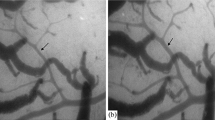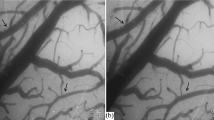Summary
The effect of the calcium entry blockers flunarizine and nimodipine on isolated human cerebral and temporal arteries has been studied.
Flunarizine induced only weak relaxation of precontracted temporal arteries in contrast to the response seen in cerebral arteries. Nimodipine invariably induced strong relaxation of both types of vessel. The effect of the calcium entry blockers on potassium (K+)-, noradrenaline (NA)- and 5-hydroxytryptamine (5-HT)-induced contraction was also examined. In general, the K−-induced contraction was inhibited by both calcium entry blockers, nimodipine being more potent than flunarizine, the cerebral artery being more sensitive. The response to K+ consisted of two phases; the second, slowly developing phase of contraction was more sensitive to either blocker than the initial, fast phase of contraction.
Flunarizine was significantly more potent in inhibiting NA-induced contraction of the human cerebral than of the temporal artery, and there was no difference in its action on 5-HT-induced contraction of either artery. The same pattern was found for nimodipine, which was more potent in every aspect. Both calcium entry blockers induced a parallel shift in calcium-induced contraction studied by application of calcium to vessels preincubated in calcium free medium. Flunarizine was more potent on cerebral than on temporal arteries and there was no difference between the two vessels in this action of nimodipine. However, the latter was more potent than flunarizine in preventing calcium-induced contraction.
The clinical implications of the two agents are discussed in relation to cerebrovascular disorders.
Similar content being viewed by others
References
Fleckenstein A (1977) Specific pharmacology of calcium in myocardium, cardiac pacemakers, and vascular smooth muscle tone. Ann Rev Pharmacol Toxicol 17: 149–166
Saida K, van Bremen C (1983) Mechanism of Ca++-antagonist-induced vasodilation (intracellular actions). Circ Res 52: 137–142
Siesjö BK (1981) Cell damage in the brain: A speculative hypothesis. J Cereb Blood Flow Metab 1: 155–185
Rothman SM, Olney JW (1987) Excitotoxicity and the NMDA receptor. Trends Neurosci 10: 299–302
Towart R (1981) The selective inhibition of serotonin induced contractions of rabbit cerebral vascular smooth muscle by calcium-antagonistic dihydropyridines. Circ Res 48: 650–657
Lazarewicz JW, Pluta R, Salinska E, Puka M (1989) Beneficial effect of nimodipine on metabolic and functional disturbances in rabbit hippocampus following complete cerebral ischemia. Stroke 20: 70–77
Louis PA (1981) Double-blind placebo-controlled prophylactic study of flunarizine (Sibelium R) in migraine. Headache 21: 235–239
Frenken CWGM, Nuijten STM (1984) Flunarizine, a new preventive approach to migraine. Clin Neurol Neurosurg 86: 17–20
Mendenopoulos G, Manafi T, Logothesis I, Bostantjopoulou S (1985) Flunarizine in the prevention of classical migraine: a placebo-controlled evaluation. Cephalalgia 5: 31–37
Sorensen PS, Hansen K, Olesen J (1986) Placebo-controlled, doubleblind, cross-over trial of flunarizine in common migraine. Cephalalgia 6: 7–14
Allen GS, Ahn HS, Preziosi TJ, Battye R, Boone SC, Chou SN, Kelly DL, Weir BK, Crabbe RA, Lavik PJ, Rosenbloom SB, Dorsey FC, Ingram CR, Mellits DE, Bertsch LA, Boisvert DP, Hundley MB, Johnson RK, Strom JA, Transon CR (1983) Cerebral arterial spasm — a controlled trial of nimodipine in patients with subarachnoidal hemorrhage. N Engl J Med 308: 619–624
Petruk KC, West M, Mohr G, Weir BK, Benoit BG, Gentili F, Disney LB, Khan MI, Grace M, Holness RO (1988) Nimodipine treatment in poor-grade aneurysm patients. Results of a multicenter double-blind placebo-controlled trial. J Neurosurg 68: 505–517
Pickard JD, Murray GD, Illingworth R, Shaw MD, Teasdale GM, Foy PM, Humphrey PR, Lang DA, Nelson R, Richards P (1989) Effect of oral nimodipine on cerebral infarction and outcome after subarachnoid haemorrhage: British aneurysm nimodipine trial. Br Med J 298: 636–642
Gelmers HJ, Gorter K, Dee Weerdt CJ, Wiezer HJA (1988) A controlled trial of nimodipine in acute ischemic stroke. N Engl J Med 318: 203–207
Gelmers HJ (1983) Nimodipine, a new calcium antagonist, in the prophylactic treatment of migraine. Headache 23: 106–109
Havanka-Kainniainen H, Hokkanen E, Myllyl» VV (1985) Efficacy of nimodipine in the prophylaxis of migraine. Cephalagia 5: 39–43
Ansell E, Fazzone T, Festenstein R, Johnson ES, Thauapalan M, Wilkinson M, Wozniak I (1988) Nimodipine in migraine prophylaxis. Cephalalgia 8: 269–272
Migraine-nimodipine European study group (MINES). (1990) European multicenter trial of nimodipine in the prophylaxis of common migraine (migraine without aura). Headache 89: 633–638
Migraine-nimodipine European study group (MINES) (1990) European multicenter trial of nimodipine in the prophylaxis of classic migraine (migraine with aura). Headache 89: 639–642
Högestätt ED, Andersson K-E, Edvinsson L (1983) Mechanical properties of the rat cerebral arteries as studied by a sensitive device for recording of mechanical activity in isolated small blood vessels. Acta Physiol Scand 117: 49–61
Fleckenstein (1983) Calcium Antagonism in Heart and Smooth Muscle. Wiley, New York, pp 1–399
Spedding M (1985) Calcium antagonist subgroups. Trends Pharmacol Sci 6: 109–114
McCulloch J, Edvinsson L (1984) Cerebrovascular smooth muscle reactivity: a critical appraisal of in vitro and in situ techniques. J Cereb Blood Flow Metabol 4: 129–139
Dalessio DJ (1980) Wolff's Headache and Other Head Pain. Oxford University Press, New York, 1–473
Peroutka SJ, Banghart SB, Allen GS (1984) Relative potency and selectivity of calcium antagonists used in the treatment of migraine. Headache 24: 55–58
Brandt L, Andersson KE, Edvinsson L, Ljunggren B (1981) Effects of extracellular calcium and of calcium antagonists on the contractile responses of isolated human pial and mesenteric arteries. J Cereb Blood Flow Metabol 1: 339–347
Holmes B, Brogden RN, Heel RC, Speight TM, Avery GS (1984) Flunarizine. A review of its pharmacodynamic and pharmacokinetic properties and therapeutic use. Drugs 27: 6–44
Vinge E, Andersson K-E, Brandt L, Ljunggren B, Nilsson L-G, Rosendal-Helgesen S (1986) Pharmacokinetics of nimodipine in patients with aneurysmal subarachnoidal haemorrhage. Eur J Clin Pharmacol 30: 421–425
Mohamed AA, McCulloch J, Mendelow AD, Teasdale GM, Harper AM (1984) Effect of the calcium antagonist nimidipine on local cerebral blood flow: relationship to arterial blood pressure. J Cereb Blood Flow Metabol 4: 206–211
Heffez DS, Passonneau JV (1985) Effect of nimodipine on cerebral metabolism during ischemia and recirculation in the mongolian gerbil. J Cereb Blood Flow Metabol 5: 523–528
Mabe H, Nagai H, Takagi T, Umemura S, Ohno M (1986) Effect of nimodipine on cerebral functional and metabolic recovery following ischemia in the rat brain. Stroke 17: 501–505
Meyer JS, Nance M, Walker M, Zetusky WJ, Dowell RE Jr (1985) Migraine and cluster headache treatment with calcium antagonists supports a vascular pathogenesis. Headache 25: 358–367
Tfelt-Hansen P, Edvinsson L, Olesen J (1989) Treatment of migraine with calcium entry blockers. Prog Basic Clin Pharmacol 2: 143–154
Jensen K, Tfelt-Hansen P, Lauritzen M, Olesen J (1985) Double-blind trial of nimodipine in the treatment of classic migraine attacks. Cephalalgia 5: 125–131
Lance JW, Lambert GA, Goadsby PJ, Zagami AS (1989) 5-hydroxytryptamine and its putative aetiological involvement in migraine. Cephalalgia 9 [Suppl 9]: 7–13
Author information
Authors and Affiliations
Rights and permissions
About this article
Cite this article
Jansen, I., Tfelt-Hansen, P. & Edvinsson, L. Comparison of the calcium entry blockers nimodipine and flunarizine on human cerebral and temporal arteries: role in cerebrovascular disorders. Eur J Clin Pharmacol 40, 7–15 (1991). https://doi.org/10.1007/BF00315132
Received:
Accepted:
Issue Date:
DOI: https://doi.org/10.1007/BF00315132




